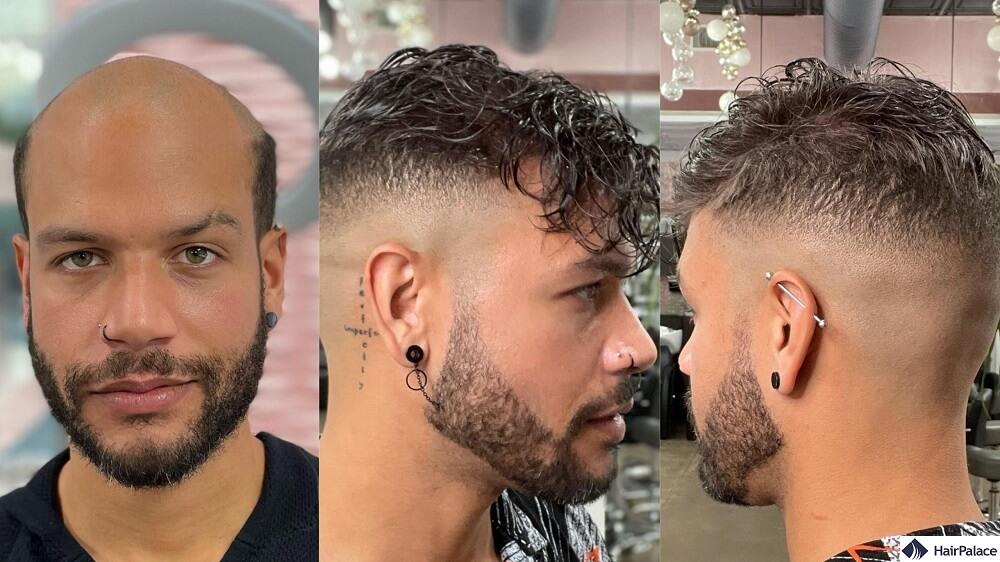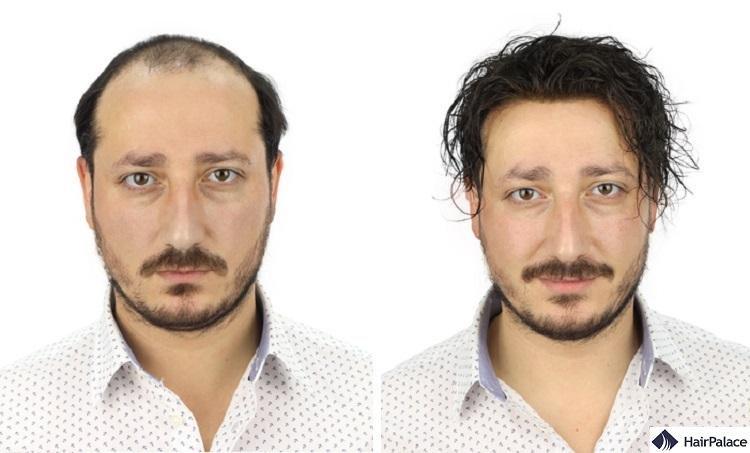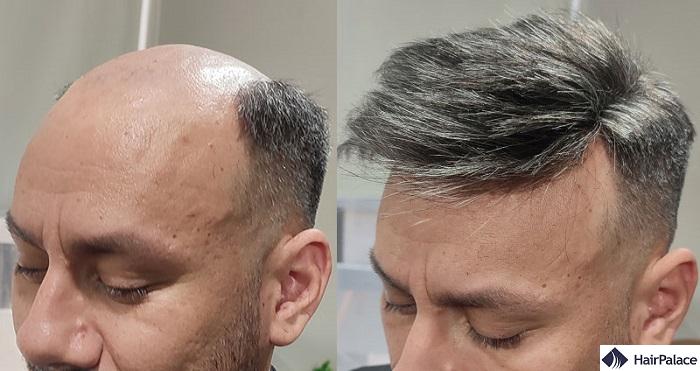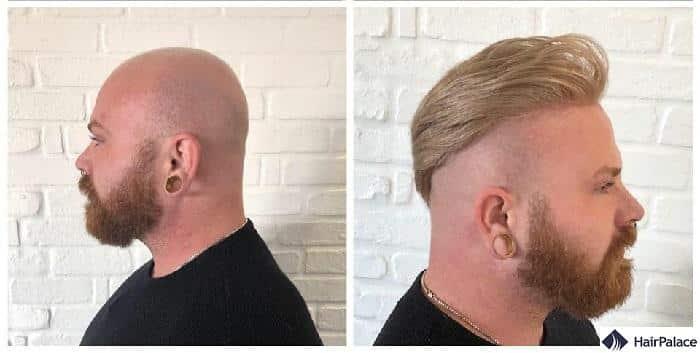Hair Replacement System For Men: The Ultimate Guide in 2025

A hair replacement system for men, also known as a hairpiece, toupee, or wig, is a non-surgical solution for hair loss.
These systems are custom-made to match the wearer’s natural hair colour, texture, and density, providing a natural appearance.
They are attached to the scalp using adhesives, clips, or weaving techniques and can be made from synthetic or human hair.
Hair replacement systems offer an immediate solution to hair loss and can be maintained with regular cleaning and reattachment sessions, providing versatility and the ability to change hairstyles easily.
If you’re considering this option, this in-depth post will help you make an informed decision.
- What is a hair replacement system?
- How does it work?
- Video tutorial
- Pros and cons
- Results
- What are the differences?
- Which technique is better?
- When to seek help
What is a hair replacement system for men?
Men’s hair replacement systems offer a non-surgical way to cover various types of hair loss.
They typically feature synthetic hair made from a fine material resembling your existing hair, though real human strands may be used instead.
How do hair replacement systems work?
Synthetic or human hairs are attached to a thin base, which is then applied to the scalp.
It’s easy to assume these systems are the same as wigs, but that’s not the case: the base is applied to the balding area of the scalp only.
A safe, dermatologically tested adhesive secures the system in place. This reduces the risk of it falling away or shifting out of place.
Hair replacement system tutorial
Find out everything you need to know about hair systems from removal to application as well as proper maintenance.
Non-surgical hair replacement UK – Pros and Cons

Pros
- Fuller head of hair without surgery
- Cheaper option with less discomfort
- The best systems are an exact match to your air colour and texture
- Results can be easily altered at any time
Cons
- Not a permanent solution
- Long-term wear can be uncomfortable
- They may come off in wet or windy weather
- A constant need for maintenance
- Much more time-consuming commitment than a hair transplant
- Poor-quality systems can give you a horrible look
Before and after non-surgical hair replacement
The best hair replacement options can offer a lasting solution whether you opt for a frontal or crown hair replacement.
Hair transplant vs hair system – How they differ
Let’s review the main differences between both options:
Non-surgical Hair replacement systems
- Feature a set of human or artificial hairs attached to a base, which is applied to the scalp
- Covers hair loss without the need for surgery
- Applied to the scalp with a dermatologically tested adhesive to avoid skin irritation
- Hairs must be cleaned and cared for to maintain their aesthetic appeal and authenticity
- Texture, colour, and growth pattern must align with existing hair to create a natural look
- Provides an illusion of hair growth rather than real restoration
Hair transplantation
- Surgeons use your hair follicles hair to create new growth in one or more areas of the scalp (e.g., the hairline or crown)
- Provides lasting growth that blends seamlessly with existing hair
- Various techniques available
- Hair follicles taken from the back and/or sides of the head to match texture and colour
- Various packages are available based on your unique needs, whether you have severe hair loss at the hairline, around the temples, or the entire top of the scalp
- Affordable pricing available at certain clinics
Hair transplant or hair system, which is better?
A non-surgical hair replacement may be an effective temporary solution if you’re preparing for a transplant or you’re unable to undergo surgery on your scalp.
But transplantation is the better option if you want to fully restore growth with your natural hairs.
There’s no need to apply a replacement system to your scalp to cover baldness — transplantation addresses hair loss directly instead of disguising it.
If you want to book a consultation with one of our experts, contact our team today to get started!
When should you visit a hair replacement specialist?
If you feel like you’re losing more hair than you should it’s always best to visit a hair replacement specialist. But what does this mean exactly?
Hair loss is usually defined as significant hair thinning or shedding beyond 50-100 hairs daily.
It’s also advised to seek help if you’ve already tried over-the-counter treatments and feel the need to go the extra mile.
Lastly, if you’re suffering from hair loss linked to certain medical conditions, medications or other atypical causes it’s best to get a proper diagnosis from an expert.
Hair Replacement System FAQ
Yes, non-surgical hair systems, such as wigs, toupees, and hairpieces, can effectively cover areas of hair loss and offer a cosmetic solution that looks and feels natural when properly fitted and chosen. However, hair transplants provide a better, long-lasting result.
The lifespan of hair systems largely depends on the material, quality, and how well they are maintained. Synthetic hair systems usually last anywhere from 4 to 6 months, while high-quality human hair systems can last 6 months to a year or longer with proper care.
The lower end of acrylic hair systems starts at around £80-£100, and stock hair systems range between £5000-£800 with human hair systems being the most expensive often costing as much as £3000. Thankfully there is a large selection of these hair systems so you’re guaranteed to find one that fits your budget.
Whether hair replacement is worth it depends on individual preferences, needs, and expectations. Ultimately, it’s a personal decision, and consulting with a hair replacement specialist can provide clarity on whether it’s the right choice.
Last medically reviewed on January 2nd, 2025
- Zito PM, Raggio BS. Hair Transplantation. Updated 2021https://www.ncbi.nlm.nih.gov/books/NBK547740/
- Rassman WR, et al. Follicular unit extraction: minimally invasive surgery for hair transplantation. Dermatol Surg 2002;28:720-8.https://doi.org/10.1046/j.1524-4725.2002.01320.x
- Sinclair, Rodney D., and Rodney P. Sinclair. "Androgenetic Alopecia in Men and Women." Clinics in Dermatology 2001;19(2):167-178https://doi.org/10.1016/S0738-081X(00)00128-0






